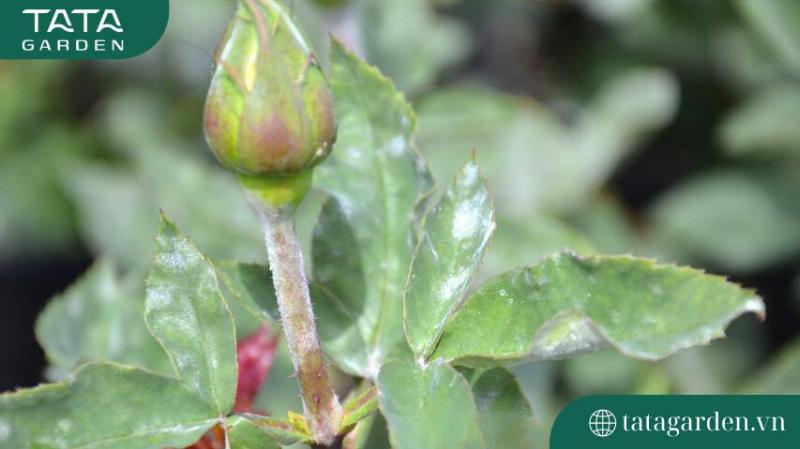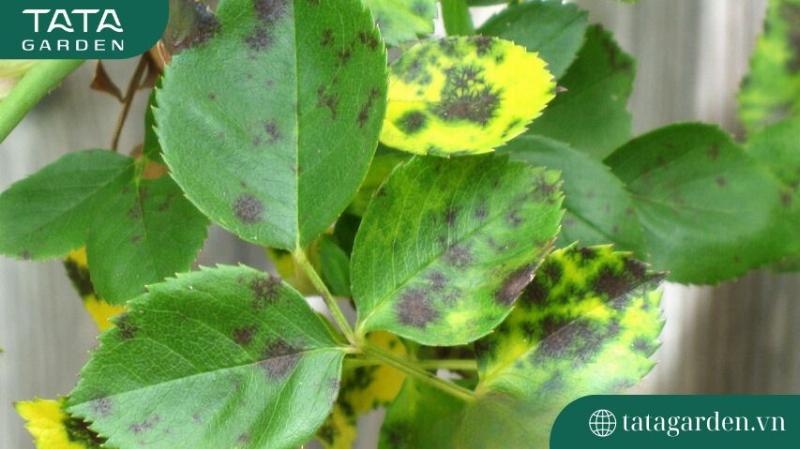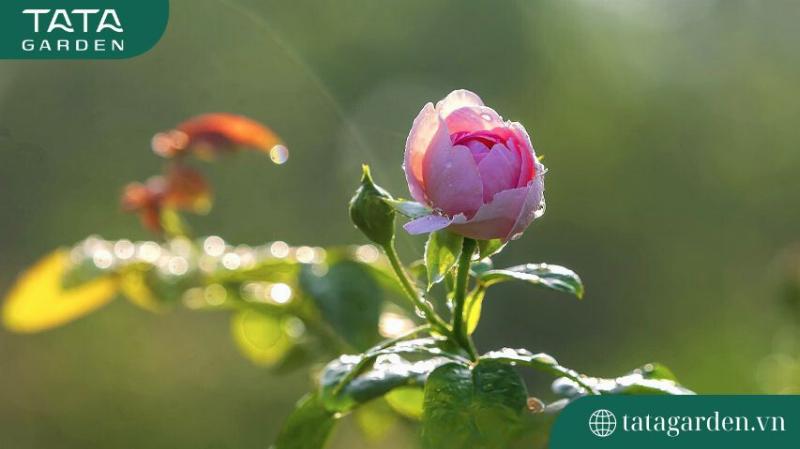Roses, the “queen of flowers,” are beloved for their elegant beauty and captivating fragrance. However, keeping these majestic plants healthy, productive, and vibrant requires diligent care. Roses are susceptible to various diseases caused by fluctuating weather conditions and harmful pests.
Understanding the concerns of rose enthusiasts, Nongnghiepvietnam.org presents a comprehensive guide to 10+ common rose diseases and their effective treatments. We hope this article equips you with the knowledge to maintain a thriving rose garden.
Top Common Rose Diseases
Rose diseases are generally categorized into two main groups: those caused by environmental factors and those caused by insect pests. Below, we detail the symptoms, causes, and treatments for each disease.
Powdery Mildew
 Rose with powdery mildew
Rose with powdery mildew
Powdery mildew is one of the most prevalent rose diseases, especially affecting climbing varieties. This disease typically appears during the rainy season when humidity levels are high.
Symptoms
- A white, powdery coating appears on leaves, buds, and new shoots.
- Leaves curl, distort, turn yellow, then reddish-purple, and eventually fall off.
- Flowers become deformed, fail to open, or open unevenly and fade quickly.
Cause
Powdery mildew is caused by the fungus Sphaerotheca pannosa var. This fungus thrives in humid conditions.
Treatment
- Dish soap solution: Mix dish soap with rubbing alcohol and water, then spray on the plant.
- Yogurt solution: Dilute plain yogurt with cooking oil and water, then spray on the plant.
- Baking soda solution: Mix baking soda with dish soap and water, then spray on the plant.
- Fungicides: In severe cases, use a fungicide specifically formulated for powdery mildew on roses.
Black Spot
 Rose with black spot
Rose with black spot
Black spot is a significant concern for many rose growers due to its rapid spread and potential to severely damage plants.
Symptoms
- Tiny black spots appear on leaves, gradually expanding into larger black patches.
- Leaves turn yellow, wither, and fall off.
- The plant weakens and may die if not treated promptly.
Cause
Black spot is caused by the fungus Diplocarpon Rosae. This fungus often appears during the rainy season or when plants are grown in infected soil.
Treatment
- Baking soda solution: Mix baking soda with dish soap and warm water, then spray on the plant.
- Fungicides: For greater effectiveness, use a fungicide specifically designed for black spot on roses.
Yellowing Leaves
 Rose with yellow leaves
Rose with yellow leaves
Yellowing leaves is a common occurrence in roses. There are several potential causes, so proper diagnosis is crucial for effective treatment.
Symptoms
- Leaves turn pale yellow, then wither and fall off.
Causes
- Underwatering or overwatering.
- Root damage.
- Lack of sunlight.
- Nutrient deficiency.
- Infection by fungi, bacteria, or insects.
Treatment
- Adjust watering practices.
- Provide adequate sunlight.
- Apply balanced fertilizer.
- Use appropriate fungicides, bactericides, or insecticides if necessary.
Downy Mildew
Downy mildew often appears in cool, humid weather. Rose plants can lose all their leaves within just two days if infected with downy mildew.
Symptoms
- Fuzzy, mold-like spots appear on leaves.
- Leaves curl, turn pale yellow or gray, then darken to purple.
- Leaves become necrotic and fall off rapidly.
Cause
Downy mildew is caused by the fungus Peronospora Sparsa. This fungus thrives in cool, damp conditions.
Treatment
- Fungicides: Fungicides containing Trifloxystrobin, Azoxystrobin, or Fosetyl-Al are effective in treating downy mildew.
Rose Leaf Curl
 Rose with leaf curl
Rose with leaf curl
Rose leaf curl can affect the plant’s ability to bloom.
Symptoms
- Leaves become wrinkled and curled.
- Light-colored streaks or patches appear on the leaves.
- Leaves become distorted and fall off.
Cause
Rose leaf curl is caused by Aphids or Thrips. These insects suck the sap from the plant, weakening it and causing leaf distortion.
Treatment
- Insecticides: Insecticides such as Bassa, Supracide, or Trebon are effective against Aphids and Thrips.
- Maintain a clean garden.
Cane Blight
Cane blight typically appears during the rainy season.
Symptoms
- Canes wilt.
- Small yellowish-brown spots appear on the canes, expanding into elongated patches.
- Canes turn black, wither, and die.
Causes
- Coniothyrium fungus.
- The plant naturally shedding weaker canes to focus nutrients on healthier ones.
- Cane borers.
Treatment
- Prune affected canes.
- Maintain a clean garden.
- Use fungicides and insecticides against cane borers if necessary.
Rose Rust
While rose rust doesn’t kill the plant immediately, it affects its growth and flowering.
Symptoms
- Bright orange spots appear on stems, leaves, buds, and flowers, developing into raised pustules.
- The pustules contain orange-yellow fungal spores.
Cause
Phragmidium tuberculatum fungus and related species.
Treatment
- Clean the area around the base of the plant.
- Prune affected canes.
- Use a fungicide specific to Phragmidium tuberculatum.
Gray Mold (Botrytis Blight)
Gray mold affects flower yield and quality.
Symptoms
- Small pink or red spots appear on flower stems.
- Petals turn brown and rot.
- Flower buds break off.
- Stems turn black and develop a gray mold.
Cause
Botrytis blight fungus.
Treatment
- Remove infected plants.
- Use fungicides containing chlorothalonil, manconeb, potassium bicarbonate, or thiophanate-methyl.
Anthracnose
Anthracnose is a common and recurring disease in roses.
Symptoms
- Sunken, circular, grayish-brown or yellowish-brown spots appear on leaves.
- The spots enlarge and turn gray with reddish-brown borders.
- Leaves become scorched and tattered.
- Buds and flowers wither and break off easily.
Cause
Colletotrichum gloeosporioides and Cephaleuros virescens fungi.
Treatment
- Prune affected canes.
- Maintain a clean garden.
- Use fungicides.
Crown Gall
Crown gall affects the vitality and aesthetics of rose plants.
Symptoms
- Tiny, light-colored bumps appear on the stems.
- The bumps grow larger, encircling the stems.
- Knotty growths also appear on the roots.
Cause
Agrobacterium tumefaciens bacteria.
Treatment
- Remove and destroy infected plants.
- Apply lime or antibiotic paste to the cut area.
- Introduce the beneficial fungus Trichoderma to the soil.
- Use fungicides.
Top Insect Pests Affecting Roses
Besides fungi and bacteria, insects are also common causes of rose diseases.
Thrips
Thrips are tiny insects that reproduce rapidly and cause significant damage to plants.
Symptoms
- Leaves become distorted and curled.
- New growth is stunted.
- Dark yellow mottled spots appear on leaves.
- Flowers develop slowly, unevenly, and with distorted shapes and pale colors.
Treatment
- Remove affected canes.
- Limit nitrogen fertilizer.
- Use insecticides specific to thrips.
Aphids
Three common types of aphids infest roses: mealybugs, scale insects, and greenfly.
Symptoms
- Mealybugs: Cluster in white masses on stems, branches, new shoots, and flower buds.
- Scale insects: Cluster on stems, resembling scaly bumps.
- Greenfly: Cluster on new shoots and branch tips.
Treatment
- Manual removal: Use a stiff brush and rubbing alcohol to remove scale insects. Use a strong stream of water to dislodge mealybugs.
- Biopesticides: Garlic and ginger-based preparations can repel aphids.
- Insecticides: Use insecticides when aphid infestations are severe.
Caterpillars
Caterpillars damage plants by feeding on leaves, flowers, buds, and new shoots.
Symptoms
- Large holes and ragged edges appear on leaves, flowers, and buds.
- Leaves curl and roll up.
- Caterpillar droppings are present.
- Buds and branches break off.
Treatment
- Use insecticides.
Spider Mites
Spider mites are sap-sucking insects that can severely damage plants.
Symptoms
- Leaves become silvery and develop tiny yellow spots.
- Leaves turn pale yellow.
- Tiny, off-white specks (spider mites) appear on the underside of leaves.
Treatment
- Remove and destroy infested leaves and branches.
- Maintain a clean garden.
- Use miticides.
Conclusion
This article provides a comprehensive overview of 10+ common rose diseases and their effective treatments. We hope this information helps you identify and address these issues promptly, ensuring a healthy and vibrant rose garden.
Share this article with your friends and family if you find it helpful! And don’t forget to visit Nongnghiepvietnam.org regularly for more valuable insights into plant cultivation and care.
